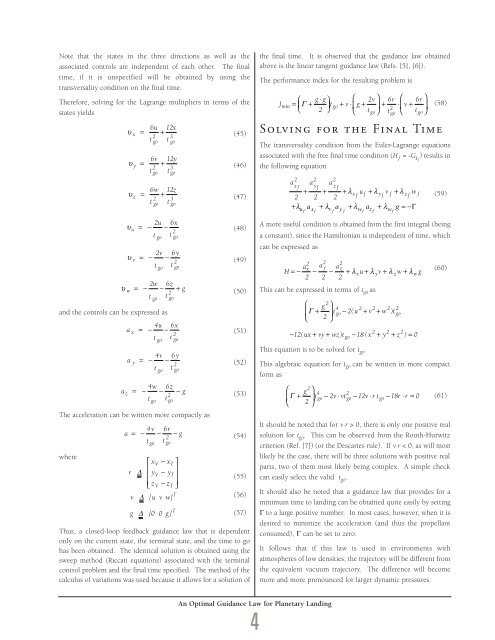1998 - Draper Laboratory
1998 - Draper Laboratory
1998 - Draper Laboratory
- No tags were found...
Create successful ePaper yourself
Turn your PDF publications into a flip-book with our unique Google optimized e-Paper software.
Note that the states in the three directions as well as theassociated controls are independent of each other. The finaltime, if it is unspecified will be obtained by using thetransversality condition on the final time.Therefore, solving for the Lagrange multipliers in terms of thestates yieldsand the controls can be expressed asThe acceleration can be written more compactly aswhereaz6u12xυ x = +2 3t go t goa xa ya6v12yυ y = +2 3t go t go6w12zυ z = +2 3t go t go2u6xυ u = − −2t go t go2v6yυ v = − −2t go t go2w6zυ w = − − + g2t go t go4w6z= − − − g2t go t go= − 4v− 6rg2t go t−gor ∆v ∆g ∆4u6x= − −2t go t go4v6y= − −2t go t go⎡ xV− xT⎤⎢ ⎥⎢yV− yT⎥⎣⎢ zV− zT⎦⎥[ u v w]T[ 0 0 g]T(45)(46)(47)(48)(49)(50)(51)(52)(53)(54)(55)(56)(57)Thus, a closed-loop feedback guidance law that is dependentonly on the current state, the terminal state, and the time to gohas been obtained. The identical solution is obtained using thesweep method (Riccati equations) associated with the terminalcontrol problem and the final time specified. The method of thecalculus of variations was used because it allows for a solution ofthe final time. It is observed that the guidance law obtainedabove is the linear tangent guidance law (Refs. [5], [6]).The performance index for the resulting problem isg gJmin = ⎛ + ⋅ ⎞ ⎛ 2v⎞⎜ ⎟ t go + ⋅ g⎝ ⎠⎜ +⎝ t go ⎠⎟ + 6rt ⋅ ⎛⎜ + 6r⎞Γvv ⎟22 t go ⎝ go ⎠Solving for the Final Time(58)The transversality condition from the Euler-Lagrange equationsassociated with the free final time condition (H ƒ = -G tƒ) results inthe following equation2 2 2a a ax f y f z f+ + + λx fuf + λy fvf + λz fw f2 2 2+ λu ax + λv ay + λw az + λwg = −Γf f f f f f f(59)A more useful condition is obtained from the first integral (beinga constant), since the Hamiltonian is independent of time, whichcan be expressed as2 2a a 2x y a zH =− − − + λxu+ λyv+ λzw+λwg2 2 2This can be expressed in terms of t go as⎛ 2g ⎞⎜Γ + ⎟tgo− 2( u + v + w ) t⎝ 2 ⎠− 12( ux + vy + wz) t go − 18( x 2 + y 2 + z2 ) = 0This equation is to be solved for t go .4 2 2 2 2go(60)This algebraic equation for t go can be written in more compactform as⎛ 2g ⎞4 2⎜Γ + ⎟tgo −2v⋅vtgo −12v⋅rtgo−18r⋅ r = 0⎝ 2 ⎠(61)It should be noted that for v·r > 0, there is only one positive realsolution for t go . This can be observed from the Routh-Hurwitzcriterion (Ref. [7]) (or the Descartes rule). If v·r < 0, as will mostlikely be the case, there will be three solutions with positive realparts, two of them most likely being complex. A simple checkcan easily select the valid t go .It should also be noted that a guidance law that provides for aminimum time to landing can be obtained quite easily by settingΓ to a large positive number. In most cases, however, when it isdesired to minimize the acceleration (and thus the propellantconsumed), Γ can be set to zero.It follows that if this law is used in environments withatmospheres of low densities, the trajectory will be different fromthe equivalent vacuum trajectory. The difference will becomemore and more pronounced for larger dynamic pressures.An Optimal Guidance Law for Planetary Landing4
















